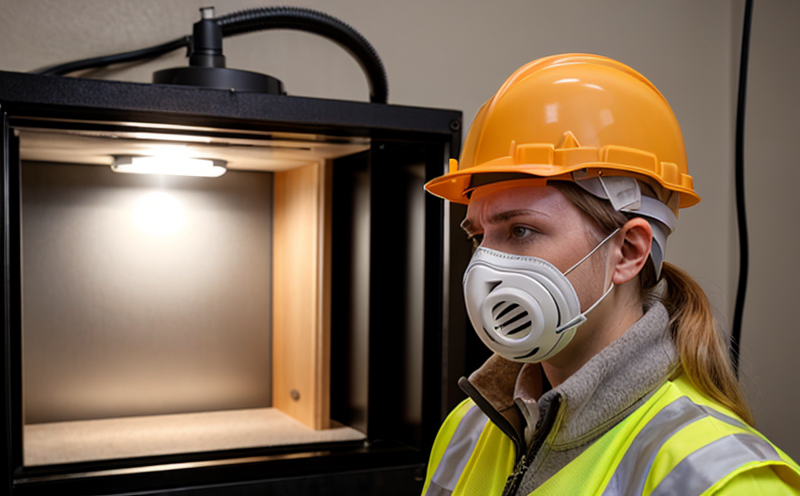Occupational Sound Exposure Compliance Testing
In the Environmental Health and Safety (EHS) sector, sound exposure is a critical concern as it can significantly impact worker health and well-being. Occupational noise-induced hearing loss remains one of the most prevalent occupational illnesses worldwide. Therefore, ensuring compliance with relevant standards and regulations for sound exposure is paramount.
The primary objective of Occupational Sound Exposure Compliance Testing is to evaluate the levels of environmental noise in workplaces where workers are exposed to potentially harmful noise levels. This testing ensures that employers comply with health and safety legislation such as ISO 1999:2017, which provides guidelines for noise exposure at work.
The testing process typically involves the deployment of sound level meters (SLMs) to measure environmental noise in decibels (dB). The measurement points are strategically chosen based on the layout and operational characteristics of the workplace. Key areas such as tool stations or high-traffic zones are monitored for peak noise levels, while average background noise is measured across broader areas.
The data collected during these tests serve to identify any potential risks associated with excessive noise exposure. The results are compared against established thresholds set by regulatory bodies like OSHA in the USA and HSE in the UK. Compliance with these standards ensures that employers can take appropriate measures to protect their workforce from the adverse effects of noise.
For effective sound exposure testing, it is essential to employ qualified personnel using calibrated instruments. Proper calibration of SLMs prior to each measurement session guarantees accurate data collection. The testing process also involves analyzing time-weighted average (TWA) values over specified periods—commonly 15 minutes or an eight-hour workday—to determine if the noise levels exceed safe limits.
Once all measurements are completed, a detailed report is generated summarizing the findings. This report includes both quantitative data such as dB readings and qualitative assessments regarding the overall acoustic environment of the workplace. It also provides recommendations for mitigating risks where necessary, which can include implementing quieter machinery or redesigning workspaces.
By adhering to strict protocols during occupational sound exposure testing, organizations not only safeguard their employees' health but also demonstrate a commitment to maintaining high standards of EHS compliance. This proactive approach helps prevent costly legal issues and enhances employee satisfaction by creating safer working conditions.
| Measurement Parameters | Description |
|---|---|
| Average Noise Level (LAeq,8h) | The total noise exposure over an eight-hour workday averaged across all frequencies. |
| Peak Sound Pressure Levels (SPL) | The highest sound pressure measured during the testing period. |
| TWA Noise Exposure Level (Ltwa) | The time-weighted average noise level over a specified period, often used for assessing daily exposure. |
Understanding and addressing occupational sound exposure is crucial in maintaining a healthy and safe work environment. Properly conducted testing plays an integral role in achieving this goal by providing actionable insights into workplace acoustics.
Eurolab Advantages
Eurolab offers unparalleled expertise in occupational sound exposure compliance testing through its comprehensive suite of services. With a team of highly skilled professionals and state-of-the-art equipment, we ensure that every aspect of your project receives the attention it deserves.
- Accurate Measurements: Our calibrated instruments deliver precise results, ensuring reliability and accuracy in all measurements.
- Comprehensive Reporting: Detailed reports provide a clear picture of workplace acoustics, highlighting areas requiring improvement.
- Regulatory Compliance: We stay updated on the latest regulations to ensure our services meet or exceed industry standards.
- Experience and Knowledge: Our team comprises experts with extensive experience in EHS compliance testing, offering valuable insights and advice.
Eurolab's commitment to excellence extends beyond mere compliance; it encompasses proactive measures aimed at enhancing workplace safety and well-being. By partnering with us, you gain access to cutting-edge technology and seasoned professionals dedicated to your success.
Environmental and Sustainability Contributions
EHS considerations are not solely about mitigating risks but also about fostering sustainable practices that benefit both the environment and society at large. In the context of occupational sound exposure compliance testing, this translates into reducing noise pollution in urban areas and industrial settings.
Noise pollution has been linked to various environmental issues such as increased stress levels among wildlife and disruption of natural habitats. By conducting thorough sound exposure tests, organizations contribute positively towards creating quieter environments outside their premises as well.
The data collected during these tests can inform better design choices for future projects, encouraging the use of less noisy materials and technologies. Furthermore, by adhering to stringent EHS practices, companies set a positive example for others in the industry, promoting overall environmental consciousness.
Use Cases and Application Examples
EHS compliance testing, particularly regarding sound exposure, finds applications across diverse industries including manufacturing, construction, transportation, and hospitality. Here are some specific use cases:
- Manufacturing Plants: Ensuring that machinery noise levels do not exceed safe limits to protect workers.
- Construction Sites: Monitoring noise emissions from heavy equipment during operations.
- Transportation Facilities: Assessing the impact of traffic noise on nearby residential areas.
- Hospitality Establishments: Reducing background noise in hotel lobbies to enhance guest comfort and satisfaction.
| Industry | Potential Risks | Treatment Options |
|---|---|---|
| Mining | Excessive noise from drilling machines | Implementing sound barriers around machinery |
| Agriculture | Noise generated by tractors and harvesters | Using quieter models or scheduling work when winds are higher |
| Healthcare | High-pitched sounds from medical equipment | Installing soundproofing materials in patient rooms |
The effectiveness of our testing services lies not just in identifying current issues but also in providing solutions that align with sustainable practices. Whether you're looking to protect your workforce or contribute positively to the environment, Eurolab is here to help.





